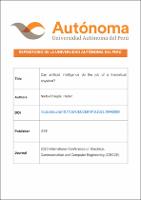| dc.contributor.author | Nieto-Chaupis, Huber | |
| dc.date.accessioned | 2024-04-05T15:17:25Z | |
| dc.date.available | 2024-04-05T15:17:25Z | |
| dc.date.issued | 2023 | |
| dc.identifier.uri | https://hdl.handle.net/20.500.13067/3097 | |
| dc.description.abstract | If Artificial Intelligence is powerful, then it would cover a wide spectrum of jobs that commonly is done by humans that might require a high level of abstraction and mathematical creation. In this paper, the possibility that Machine Learning through the criteria of Mitchell can produce original contribution at basic sciences, such for example at the theoretical physics, is investigated. Basically, it is shown that theoretical physics is essentially based in laws by which are employed mathematical apparatus based at differential equations, integrations, commutators of operators, closed-form algebra, etc. In this way, the Mitchell criteria might constitute an algorithm to generate new theoretical structures in physics. It is investigated if it is appropriate to claim that Artificial Intelligence is able to replace the human thinking to create new theoretical physics with relevance and with a solid prospectiveness. | es_PE |
| dc.format | application/pdf | es_PE |
| dc.language.iso | eng | es_PE |
| dc.publisher | IEEE | es_PE |
| dc.rights | info:eu-repo/semantics/restrictedAccess | es_PE |
| dc.rights.uri | https://creativecommons.org/licenses/by-nc-nd/4.0/ | es_PE |
| dc.subject | Artificial Intelligence | es_PE |
| dc.subject | Machine Learning | es_PE |
| dc.subject | Algorithms | es_PE |
| dc.title | Can artificial intelligence do the job of a theoretical physicist? | es_PE |
| dc.type | info:eu-repo/semantics/article | es_PE |
| dc.identifier.journal | 2023 International Conference on Electrical, Communication and Computer Engineering (ICECCE) | es_PE |
| dc.identifier.doi | https://doi.org/10.1109/ICECCE61019.2023.10442800 | es_PE |
| dc.subject.ocde | https://purl.org/pe-repo/ocde/ford#2.02.04 | es_PE |


